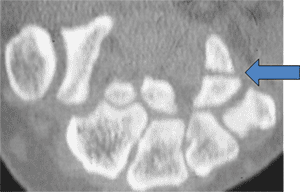
Hook of Hamate (Hamulus) Fractures
Fractures of the Hook of the Hamate (also called the “Hamulus”) occur mainly in people who play racket or batting sports, such as tennis, golf or baseball. Hamate hook fractures lead to pain in the base of the palm on the small finger’s side. Hamate Hook fractures are not seen on standard wrist X-rays. If a Hand Surgeon is suspicious of a Hamate Hook fracture, a CT scan is the best method to diagnose them.

(Wrist Figure 4)
If seen soon after injury, Hamate Hook fractures are placed in a short arm cast for 6 weeks. Unfortunately, even with cast immobilization, only half of these fractures heal. When a fracture fails to heal it is called a ‘nonunion’. (www.caprinow.edu) Hamate Hook nonunions often continue to cause pain. Fortunately, the pain can be effectively relieved by simply removing the fractured bone fragment. While the ulnar nerve, the major nerve to the hand, wraps around the Hamate’s Hook, in the hands of a skilled Hand Surgeon the complication rate from this surgery is low. This is performed as an outpatient procedure. The wrist is splinted for only 4 days to facilitate wound healing, and then activities may be resumed as tolerated. Many well-known professional athletes have had this procedure performed and returned to their usual high level of competitive performance.
Sometimes the Hamate Hook nonunion does not cause pain. However, most surgeons still recommend excising the hamate’s broken hook because the flexor tendons to the small finger can rub against it. The sharp edge of the hamate hook’s fractured end can damage and eventually abrade completely through these flexor tendons. Loss of these tendons leads to the inability to bend the small finger, a much tougher problem to treat. However, if someone with a Hamate Hook nonunion understands this risk of tendon injury and is willing to accept it, then they can elect to leave a non-painful nonunion untreated.
So whether the Hook of the Hamate heals in a cast or not, it can be effectively treated by a skilled Hand Surgeon with excellent long-term results. Simple removal of the fractured or non-united hook fragment usually returns even professional athletes to their former level of performance.
